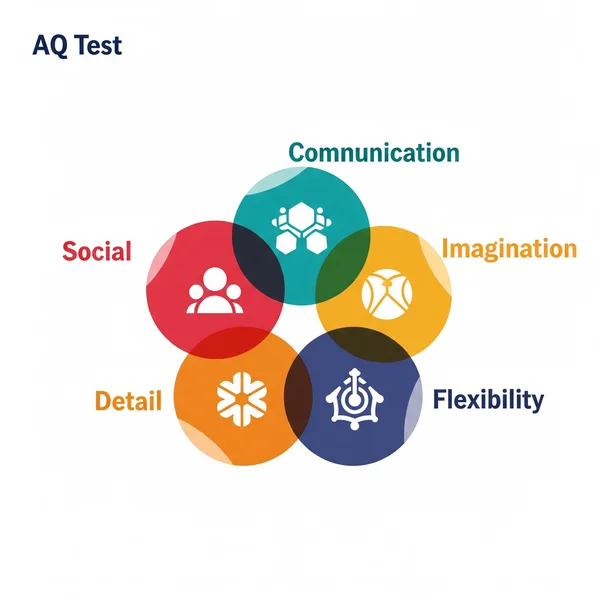Unveiling the AQ Test: Origin, Purpose, and Structure of the Autism Spectrum Quotient for Adults
Have you ever wondered about your unique cognitive and behavioral traits, particularly those associated with the autism spectrum? What is the AQ Test for, and how can it help in the journey of self-discovery? The Autism Spectrum Quotient (AQ) Test is a widely recognized self-assessment tool designed to measure these traits in adults. If you're curious to learn more about this valuable resource, you can explore the AQ Test on our platform.
The AQ Test provides a quantitative measure of autistic traits, offering insights that can be pivotal for personal understanding and further exploration. This guide will delve into the origins, purpose, structure, and significance of the aq test, helping you understand what the autism spectrum quotient truly represents.

What Exactly is the Autism Spectrum Quotient (AQ) Test?
So, how does the AQ Test work? The Autism Spectrum Quotient (AQ) Test is a questionnaire developed to assess the degree to which an adult with normal intelligence has traits associated with the autism spectrum. It's a key instrument in both clinical settings for initial screening and in research for understanding the broader autism phenotype.
The Origins: Simon Baron-Cohen and the AQ Test Development
The credit for the AQ Test goes to Professor Simon Baron-Cohen and his colleagues at the Autism Research Centre at the University of Cambridge. They first published this assessment tool in 2001. The Baron-Cohen AQ Test was born out of a need for a standardized, self-administered questionnaire that could help quantify autism traits in adults, contributing significantly to research on adult autism and neurodiversity.
Core Purpose: Why Was the AQ Test Created?
What is the AQ Test for primarily? The core purpose of the AQ Test is to provide a quick and easy way for adults to get an indication of where they might fall on the autism spectrum. It serves as a screening questionnaire, not a diagnostic tool, but it can be an invaluable first step in understanding one's own cognitive styles and social preferences. It also aids researchers in studying the distribution of autistic traits in the general population. For a practical understanding, you might consider how you can understand yourself better with the AQ Test.
Who is the AQ Test For? Target Adults (16+)
Who can take the AQ Test? The AQ Test is specifically designed for adults aged 16 and older who have an average or above-average intelligence. It is not intended for children. Many individuals who suspect they might have autistic traits, or those simply curious about their communication patterns and other characteristics, find the self-assessment autism aspect of the AQ Test beneficial.
Deconstructing the AQ Test: Structure and Key Domains
Understanding the structure of the AQ Test is crucial to appreciating its comprehensiveness. It’s more than just a random set of questions; it’s a carefully constructed instrument.
The 50-Question Framework of the AQ Test Online
The AQ Test consists of 50 questions. Each question presents a statement, and the individual rates how strongly they agree or disagree with it. This format allows for a nuanced reflection on various personal experiences and preferences. You can experience this framework directly when you take our AQ Test online. These 50 questions are designed to be completed relatively quickly, usually within 5-10 minutes.
Exploring the Five Core Domains Measured by the AQ Test
The AQ Test measures autistic traits across five domains, each contributing to the overall autism spectrum quotient score. These domains are:
-
Social Skills: This assesses aspects like reciprocal social interaction and understanding social cues. For instance, finding it hard to understand other people's intentions.
-
Communication: This domain looks at
communication patterns, including difficulties with pragmatic language or understanding figurative speech. -
Imagination: This area explores imaginative abilities and flexibility of thought.
-
Attention to Detail: This focuses on a preference for detail over the bigger picture and an aptitude for recognizing patterns.
-
Attention Switching / Tolerance of Change: This assesses how an individual copes with changes in routine and their ability to switch focus.

A deeper understanding of these five domains can offer significant insights into one's personal cognitive styles. We plan to explore each of these domains in more detail in future articles.
The Significance of the AQ Test as a Self-Assessment Tool
The AQ Test holds considerable significance as a self-assessment autism tool, empowering individuals in their journey of self-discovery.
Understanding Your Traits: How the AQ Test Can Offer Insights
How can an assessment tool like the AQ Test offer personal insights? By providing a structured way to reflect on behaviors and preferences that align with known autism traits, the AQ Test can help individuals identify patterns they may not have previously recognized or understood. This awareness is often the first step towards greater self-acceptance and can open doors to exploring neurodiversity more broadly.
Limitations: What the AQ Test is NOT (Not a Diagnostic Tool)
It is crucial to understand the limitations of the AQ Test. While it is a valuable screening questionnaire, it is not a diagnostic tool. A high score on the AQ Test suggests the presence of autistic traits but does not confirm an Autism Spectrum Condition (ASC) diagnosis. Is the AQ Test reliable enough for diagnosis? No, a formal diagnosis can only be made by a qualified healthcare professional through a comprehensive clinical assessment. The AQ Test is a starting point. If you have concerns, you can find out more about the AQ Test on our site before seeking professional advice.

Key Takeaways: Embracing Self-Understanding with the AQ Test
The AQ Test is a valuable instrument developed by Baron-Cohen in 2001 that offers adults a way to explore their autism traits through a simple, 50-question format. It provides insights into social skills, communication patterns, and other key areas, fostering self-discovery.
Remember, the autism spectrum quotient is a measure of traits, not a definitive label. It’s a tool to enhance self-awareness within the broader context of neurodiversity.
Frequently Asked Questions about the AQ Test
Here are some common questions individuals have about the AQ Test:
-
Is the AQ test only for adults? Yes, the
AQ Testis specifically designed for adults aged 16 years and older. It is not validated for use with children. -
How long does the online AQ test take? Typically, completing the AQ Test online takes about 5 to 10 minutes. It consists of 50 concise questions.
-
Can the AQ test diagnose autism? No, the
AQ Testcannot diagnose autism. It is a self-assessment screening tool that indicates the presence of autistic traits. A formal diagnosis requires a comprehensive evaluation by a qualified professional. What does a high AQ score mean in this context? It suggests further exploration with a professional might be beneficial. -
Who developed the Autism Spectrum Quotient (AQ) test? Professor Simon Baron-Cohen and his research team at the University of Cambridge developed the
Autism Spectrum Quotient (AQ) Testin 2001. -
Where can I take an official AQ Test online? You can take a version of the AQ Test right here. We invite you to try our AQ self-assessment tool now to begin your journey of self-understanding.
We hope this guide has clarified what the AQ Test is and how it can be a useful tool for adults. Understanding your autism spectrum quotient can be an enlightening experience.
What are your thoughts or experiences with self-assessment tools like the AQ Test? If you found this article helpful, please consider sharing it with others who might benefit. For more in-depth information, you might be interested in our upcoming articles on AQ Test accuracy and interpreting your results.